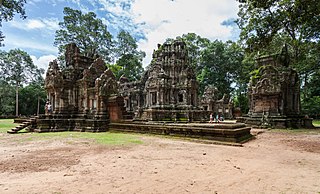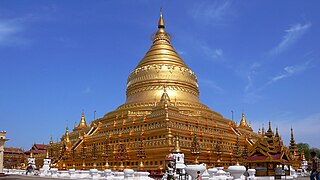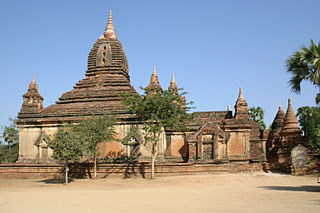
The Ajanta Caves are approximately 30 rock-cut Buddhist cave monuments which date from the 2nd century BCE to about 480 CE in Aurangabad district of Maharashtra state of India. The caves include paintings and rock-cut sculptures described as among the finest surviving examples of ancient Indian art, particularly expressive paintings that present emotions through gesture, pose and form.

Avalokiteśvara or Padmapani is a bodhisattva who embodies the compassion of all Buddhas. This bodhisattva is variably depicted, described and portrayed in different cultures as either male or female. In Tibet, he is known as Chenrezig. In Chinese Buddhism, Avalokiteśvara has evolved into the somewhat different female figure Guanyin, also known in Japan as Kanzeon or Kannon. In Nepal Mandal this figure is known as Jana Baha Dyah, Karunamaya, Seto Machindranath.

Lotus position or Padmasana is a cross-legged sitting meditation pose from ancient India, in which each foot is placed on the opposite thigh. It is an ancient asana in yoga, predating hatha yoga, and is widely used for meditation in Hindu, Tantra, Jain, and Buddhist traditions.

Donglin Temple is a Buddhist monastery approximately 20 kilometres (12 mi) from Jiujiang, in the north of Jiangxi province, China. Built in 386 CE at the foot of Lushan by Huiyuan, founder of the Pure Land Sect of Buddhism, it is well known for how long it has stood without collapsing.

Chau Say Tevoda is a temple at Angkor, Cambodia. It is just east of Angkor Thom, directly south of Thommanon across the Victory Way. Built in the mid-12th century, it is a Hindu temple in the Angkor Wat period. It is dedicated to Shiva and Vishnu with unique types of female sculptures of devatas enshrined in it. The Buddha images have been interpreted to have been built during the reign of Dharanindravarman, father of Jayavarman VII, who ruled from Preah Khan of Kompong. The temple was in a dilapidated state with 4,000 of its elements lying scattered on the embankment and in the Siem Reap River. Many of these elements were used in the restoration work carried out by a Chinese team between 2000 and 2009 under a project sponsored by the People's Republic of China. The temple was reopened in late 2009.

Phnom Bakheng at Angkor, Cambodia, is a Hindu and Buddhist temple in the form of a temple mountain. Dedicated to Shiva, it was built at the end of the 9th century, during the reign of King Yasovarman (889-910). Located atop a hill, it is nowadays a popular tourist spot for sunset views of the much bigger temple Angkor Wat, which lies amid the jungle about 1.5 km to the southeast. The large number of visitors makes Phnom Bakheng one of the most threatened monuments of Angkor. Since 2004, World Monuments Fund has been working to conserve the temple in partnership with APSARA.

Vajrapāṇi is one of the earliest-appearing bodhisattvas in Mahayana Buddhism. He is the protector and guide of Gautama Buddha and rose to symbolize the Buddha's power.

The Jokhang, also known as the Qoikang Monastery, Jokang, Jokhang Temple, Jokhang Monastery and Zuglagkang, is a Buddhist temple in Barkhor Square in Lhasa, the capital city of Tibet. Tibetans, in general, consider this temple as the most sacred and important temple in Tibet. The temple is currently maintained by the Gelug school, but they accept worshipers from all sects of Buddhism. The temple's architectural style is a mixture of Indian vihara design, Tibetan and Nepalese design.

The Konbaung dynasty, formerly known as the Alompra dynasty, or Alaungpaya dynasty, was the last dynasty that ruled Burma/Myanmar from 1752 to 1885. It created the second-largest empire in Burmese history and continued the administrative reforms begun by the Toungoo dynasty, laying the foundations of the modern state of Burma. The reforms, however, proved insufficient to stem the advance of the British, who defeated the Burmese in all three Anglo-Burmese wars over a six-decade span (1824–1885) and ended the millennium-old Burmese monarchy in 1885.

In Hindu mythology, a kinnara is a paradigmatic lover, a celestial musician, part human, part horse and part bird. In Buddhist mythology, two of the most beloved mythological characters are the benevolent half-human, half-bird creatures known as the Kinnara and Kinnari, which are believed to come from the Himalayas and often watch over the well-being of humans in times of trouble or danger. Their character is clarified in the Adi Parva of the Mahabharata, where they say:
We are everlasting lover and beloved. We never separate. We are eternally husband and wife; never do we become mother and father. No offspring is seen in our lap. We are lover and beloved ever-embracing. In between us we do not permit any third creature demanding affection. Our life is a life of perpetual pleasures.

The Ananda Temple, located in Bagan, Myanmar is a Buddhist temple built in 1105 AD during the reign (1084–1112/13) of King Kyansittha of the Pagan Dynasty. The temple layout is in a cruciform with several terraces leading to a small pagoda at the top covered by an umbrella known as hti, which is the name of the umbrella or top ornament found in almost all pagodas in Myanmar. The Buddhist temple houses four standing Buddhas, each one facing the cardinal direction of East, North, West and South. The temple is said to be an architectural wonder in a fusion of Mon and adopted Indian style of architecture. The impressive temple has also been titled the "Westminster Abbey of Burma". The temple has close similarity to the Pathothamya temple of the 10th–11th century, and is also known as “veritable museum of stones”.

The Shwezigon Pagoda or Shwezigon Paya is a Buddhist stupa located in Nyaung-U, Myanmar. A prototype of Burmese stupas, it consists of a circular gold leaf-gilded stupa surrounded by smaller temples and shrines. Construction of the Shwezigon Pagoda began during the reign of King Anawrahta, the founder of the Pagan Empire, in 1059–1060 and was completed in 1102, during the reign of his son King Kyansittha. Over the centuries the pagoda had been damaged by many earthquakes and other natural calamities, and has been refurbished several times. In recent renovations it has been covered by more than 30,000 copper plates. However, the lowest level terraces have remained as they were.

The Buddhavaṃsa is a hagiographical Buddhist text which describes the life of Gautama Buddha and of the twenty-four Buddhas who preceded him and prophesied his attainment of Buddhahood. It is the fourteenth book of the Khuddaka Nikāya, which in turn is the fifth and last division of the Sutta Piṭaka. The Sutta Piṭaka is one of three pitakas which together constitute the Tripiṭaka, or Pāli Canon of Theravāda Buddhism.

The Nyethang Drolma Temple is a temple in Nyêtang in the Tibet Autonomous Region of China dedicated to Tara. It is associated with Atiśa (980–1054), who founded the Kadam school of Tibetan Buddhism. The monastery survived the Cultural Revolution relatively undamaged. It is dedicated to Tara, a female bodhisattva, and contains many statues and paintings of Tara.

Ngwe Gaing was a Burmese artist who worked in both oil and watercolor. After the death of his teacher Ba Nyan, he was recognized as the greatest living painter in Myanmar. He had great influence on the next generation of artists, and his works are now highly sought after.

Vasundharā or Dharaṇī is a chthonic goddess from Buddhist mythology of Theravada in Southeast Asia. Similar earth deities include Pṛthivī, Kṣiti, and Dharaṇī., She is the same with Vasudhara bodhisattva in Mahayana and Vajrayana ) and Bhoomi devi and Prithvi in hinduism.

Vientiane is a prefecture of Laos, in the northwest Laos. The national capital, Vientiane, is in the prefecture. The prefecture was created in 1989, when it was split off from Vientiane Province.

The Gubyaukgyi temple, located just south of Bagan, Myanmar, in Myinkaba Village, is a Buddhist temple built in 1113 AD by Prince Yazakumar, shortly after the death of his father, King Kyansittha of the Pagan Dynasty. The temple is notable for two reasons. First, it contains a large array of well-preserved frescoes on its interior walls, the oldest original paintings to be found in Bagan. All of the frescoes are accompanied by ink captions written in Old Mon, providing one of the earliest examples of the language's use in Myanmar. Second, the temple is located just to the west of the Myazedi pagoda, at which was found two stone pillars with inscriptions written in four, ancient Southeast Asian languages: Pali, Old Mon, Old Burmese, and Pyu. The inscription on the pillar displayed by the Myazedi pagoda has been called the Burmese Rosetta Stone, given its significance both historically and linguistically, as a key to cracking the Pyu language.

Sri Subodharama Raja Maha Vihara is a historic Buddhist temple situated at Dehiwala in the Western province, Sri Lanka. The temple is located at the Dehiwala junction on the Colombo-Galle main road, about 9 miles south of Colombo city. The temple has been formally recognised by the Government as an archaeological site in Sri Lanka. The designation was declared on 23 February 2007 under the government Gazette number 1486.

Wannian Temple is a Buddhist temple located at the foot of Camel Mountain Range of Mount Emei, in Emeishan City, Sichuan, China. It is one of the six earliest Buddhist temples on Mount Emei. The temple is situated at the foot of Camel Mountain Range, facing the Daping Temple, Niuxin Temple, Shisun Summit and Bomeng Summit (钵孟峰) in the front. Wannian Temple is known not only for the bronze statue of Samantabhadra, but also for the Beamless Brick Hall.






















